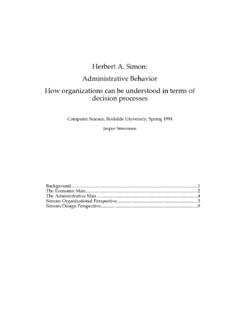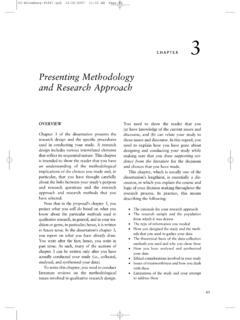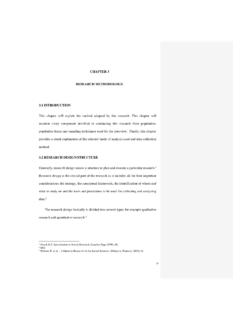Transcription of Soft Systems Methodology - Jesper Simonsen
1 soft Systems Methodology An Introduction Computer Science/Roskilde University, Spring 1994. Jesper Simonsen soft Systems SSM 1981 ..2. Stage 1 and Stage Stage Stage Stage 6 and SSM 1990 ..7. The Stream of Logic-Based The Stream of Cultural Enquiry ..11. SSM and the Construction of IS ..12. Table of Key Concepts and The Philosophy of The Work Analysis' Critique of soft Systems Methodology An Introduction, Jesper Simonsen 1. soft Systems Methodology This is a note for the lecture on Checkland's soft system Methodology (SSM). held on March 29, 2000 on Department of Computer Science, Roskilde University.
2 It is a short introduction to SSM based on two primary literature's, - Checkland, Peter: Systems Thinking, Systems Practice. Chichester, West Sussex, UK, 1981, (referred to as SSM, 81), and - Checkland, Peter, and Ji Scholes: soft Systems Methodology in Action. Chichester, West Sussex, UK, 1990, (referred to as SSM, 90). First some background for SSM is given followed by a description of SSM as described in (SSM, 81) and the revised SSM as described in (SSM, 90). SSM and the construction of Information Systems (IS) is briefly mentioned and, as a summary, a table of key concepts and techniques/guidelines is presented.
3 Finally, the philosophy of SSM and the Work Analysis' critique of SSM is described. Background SSM was developed in the 1970s by Peter Checkland and others at Department of Systems , University of Lancaster. The SSM approach stems from the ' Systems movement', which Checkland see as an attempt to give holistic approaches to problems, which the traditionally reductionistic approach within natural science has failed to solve. The Systems movement can be located within disciplines as Biology, Ecology, Economics, Geography, Demography, Management (Operational Research), Engineering, and Cybernetics.
4 Checkland distinguish between 'hard' and ' soft ' Systems thinking within the attempt to use system concepts to solve problems. Hard Systems thinking is identified within Systems Engineering (as the tra- ditional research strategy or design approach for engineers and technologists). and Systems Analysis (as the systematic appraisal of the costs and other implications of meeting a defined requirement in various ways). SE [ Systems Engineering] is the totality of an engineering project in the broadest sense of that term; SA [ Systems Analysis] is a type of appraisal relevant both to the decision- making which ought to proceed the setting up of any engineering project and to the early stages of such a project once it is started (SSM, 81, p.)
5 138). Hard Systems thinking has the starting point in 'structured' problems and the assumption that the objectives of the Systems concerned are well defined and consistent. [A]t the core of both SE and SA, is the single idea which links them, the idea that an important class of real-world problems can be formulated in the following way: there is a desired state, S1, and a present state, S0, and alternative ways of getting from S0 to S1. 'Problem solving', according to this view, consists of defining S1 and S0 and selecting the best means of reducing the differences between them.
6 Thus, in SE, (S1 - S0) defines the soft Systems Methodology An Introduction, Jesper Simonsen 2. 'need', or the objective to be attained, and SA provides an ordered way of selecting the best among the alternative Systems which could fulfil that need. The belief that real-world problems can be formulated in this way is the distinguishing characteristic of all 'hard' Systems thinking, whether it emerges from SE or SA. (SSM, 81, p. 138). All problems ultimately reduce to the evaluation of the efficiency of alternative means for a designated set of objectives.
7 (Ackoff, 571 quoted from SSM, 81, p. 155). soft Systems thinking has the starting point in 'unstructured' problems within social activity Systems in which there is felt to be an ill-defined problem situation. It became clear that the present research was to be concerned not with problems as such but with problem situations in which there are felt to be unstructured problems, ones in which the designation of objectives is itself problematic (SSM, 81, p. 155). Checkland refers to hard Systems thinking as the 'optimization paradigm' while soft Systems thinking is referred to as the 'learning paradigm' (SSM, 81, p.)
8 258). The core of SSM is to use and apply Systems ideas developed within hard Systems thinking in " soft " situations: in problem solving in the typically situation where management in an organization wants to improve a situation and the problems and the situation itself only can be stated in very general and vague terms. Hence SSM is an approach which in a systematic way tries to establish and structure a debate concerning actions for improving the problem situation. A main outcome of the work [..] emerges from research experiments as a system -based means of structuring a debate, rather than as a recipe for guaranteed efficient achievement.
9 (SSM, 81 p. 150). SSM is seen as a general problem-solving approach appropriate to human activity Systems , where the starting point of the Methodology does not take a problem or a need as given (SSM, 81, p. 191). SSM 1981. SSM was in Checkland's book from 1981 (SSM, 81) summarized in a diagram with 7 stages which later literature often has referenced, see figure 1. 1 Ackoff, R. L. (1957): "Towards a Behavioural Theory of Communication", in Buckley, W. (Ed.): Modern Systems Research for the Behavioural Scientist, Chicago: Aldine. 1968. soft Systems Methodology An Introduction, Jesper Simonsen 3.
10 Figure 1: The Methodology in summary (SSM, 81 p. 163). It is emphasized, though, that SSM should not be treated as a technique (in terms of a recipe) or a method, but as a Methodology . My sense of the word [ Methodology ] here is that the outcome of the research is not a method but set of principles of method which in any particular situation have to be reduced to a method uniquely suitable to that particular situation. (SSM, 81 pp. 161f). As indicated in figure 1, SSM deals with two kinds of activity, 'real-world'. activities involving people in the problem situation and ' Systems thinking'.



